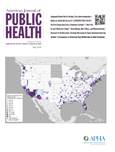
Association Between Social Network Communities and Health Behavior: An Observational Sociocentric Network Study of Latrine Adoption in Rural India
Abstract
OBJECTIVES: We identified communities of interconnected people that might serve as normative reference groups for individual-level behavior related to latrine adoption.
METHODS: We applied an algorithmic social network method to determine the network community from respondent-reported social ties of 16 403 individuals in 75 villages in rural Karnataka, India; data were collected from 2006 to 2008. We used multilevel modeling to test the association between latrine ownership and community-level and village-level latrine ownership. We also investigated the degree to which network cohesion affected individual latrine ownership.
RESULTS: Three levels of social contacts (direct friends, social network community, and village) significantly predicted individual latrine ownership, but the strongest effect was found at the level of social network communities. In communities with high levels of network cohesion, the likelihood was decreased that any individual would own a latrine; this effect was significant only at lower levels of latrine ownership, suggesting a role for network cohesion in facilitating the nonownership norm.
CONCLUSIONS: Although many international health and development interventions target village units, these results raise the possibility that the optimal target for public health interventions may not be determined through geography but through social network interactions.
Citation:
H. Shakya, N.A. Christakis, and J.H. Fowler, "Association Between Social Network Communities and Health Behavior: An Observational Sociocentric Network Study of Latrine Adoption in Rural India" American Journal of Public Health, 104(5): 903-907 (May, 2014) doi: 10.2105/AJPH.2013.301811